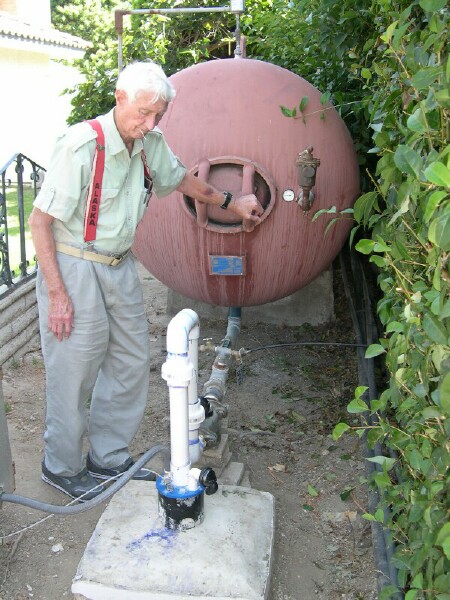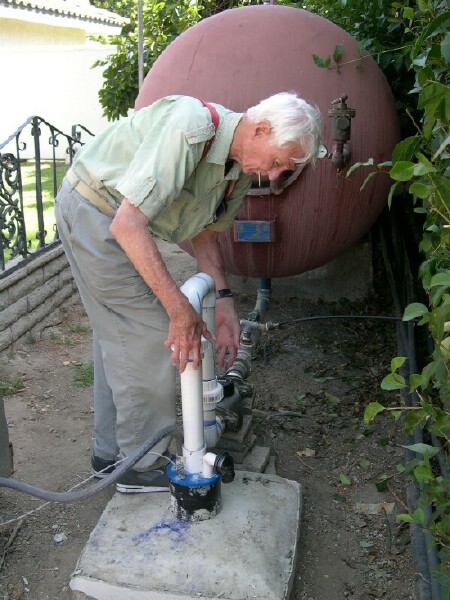Not part of Mom's 2004 OPL book but I thought we'll add a few more photos as they come up.
John
 |
 |
We now have a new team of OPL residents who keep OPL in water.
Thank you guys!
PIRATE WATER CO.
|
I found some OPL Water Well letters from Pop, and to me they are quite
interesting.
|
| Notification to chlorinate Jan. 8, 2003 NEED TO CHLORINATE AGAIN The Health Department has informed us that we are sill slightly contaminated. It is minor but state law requires chlorination. (Just a fraction of a point lower and we would not need to chlorinate) DATE we will chlorinate on Friday, Jan 10. TIME Chlorination will start at 9 AM Chlorination will take place during the daytime in order to take advantage of a new procedure that will hopefully complete the procedure and lower the chlorine concentration enough to be able to use the water in our homes by 6 pm. The chlorine level will be extremely high. Showering or drinking the water would be dangerous to your health. Until the procedure is completed, DO NOT USE ANY WATER. Suggest that you store some water before 9 AM for use during the day. WHAT YOU MUST DO: AT 9 AM TURN OFF ALL WATER, INCLUDING SPRINKLERS. (OCCASIONAL FLUSHING OF TOILETS IS OK, AND I DO MEAN OCCASIONAL) BY 6 PM THE CHLORINE LEVEL SHOULD BE LOW ENOUGH TO USE; HOWEVER, USE CAUTION IN DRINKING. IF THE CHLORINE CONCENTRATION IS STILL DANGEROUSLY HIGH AT 6 PM WE WILL TRY TO CALL EVERYONE. WHAT IS GOING TO HAPPEN: At 9 AM we will add chlorine to well and get it into tank. Will then run some hoses to get the high concentration into the mains where it will remain for approximately 4 hours. We will then drain the tank by running water hoses into the street until the measured chlorine level is down to a safe level. We are not allowed to let the water with high chlorine run into the storm drains; so we may have to ask some of you who are home in the afternoon to turn on water in your homes . If you are going to be home Friday afternoon, please let Bob Runyard, 846-1521; know in order that I can call you to turn on your water. Bob Runyard |
| Sept. 17, 2005 Bob Runyard WELL DRILLING AND PLASTIC LINING I talked to Larry Honeyborne of Orange Co. Health Dept regarding drilling a new well on Old Pirate Lane. Larry said that the Health Dept is the one who issues permits for such a project. Permit cost is around $600. Permit is subject to a number of environmental issues. The most serious for us is the presence of the sewer line in the street. A well must be 50 feet from a sewer line. If it is closer the sewer must be encased in concrete for what ever length is within a 50 foot radius of the new well. A permit would also be required from the City of Huntington Beach. Larry did not know the cost of this permit, but did not think that the city would deny the permit as O.C. Health Dept has primary jurisdiction. The following information was obtained in a phone call to Paul Stehly of Stehly Bros. Drilling Inc. in Valley Center, CA. Their phone number is 760-742-3668, FAX 760-742-4564. A plastic liner pipe is feasible for our well. It consists of inserting schedule 40 plastic pipe (bell end – no couplings) that has been perforated to allow water in. The pipe is approx 5” O.D., 5 ½” O.D. at the bell, and an I.D. of 4 3/8”. A special sand is packed around the pipe. Paul said that this size pipe is satisfactory for a 3 HP 3” dia. Pump. The approx cost of installation, including cost of their coming up here from Valley Center, would be $2,200. I asked the current cost of drilling a new well and he said around $12,000. Incidentally they would put in the same plastic pipe as a casing as I mentioned above. (no steel casing to rust) The price also includes sealing of the casing to prevent surface contamination. He said they could drill as close as 4 feet if necessary, but there would be an additional cost of filling and sealing our old well with concrete. No quote on this. Then there is the additional cost of sealing the sewer pipe as I mentioned in the second paragraph. I would suggest that we have the plastic pipe installed in about 6 years, before the pump fails. Install a new pump at the time also. |
| FROM THE SAT. REGISTER. MAYBE WE SHOULD TRY THIS NEXT TIME. THE RECIPE WHICH DID NOT TRANSFER: 1 CUP BLEACH + 1 CUP VINEGAR TO A GALLON OF WATER. BOB Saturday, February 18, 2006 Study: Vinegar and bleach are a killer combo The cleaning solution can wipe out almost any microbe, including anthrax. By NANCY KERCHEVAL Bloomberg Adding a cup of white vinegar to diluted household bleach produces a cleaning cocktail powerful enough to wipe out almost any disease- causing microbe, including anthrax, according to a study presented Friday by MicroChem Lab Inc. Vinegar changes the character of household bleach from alkaline to acidic. In the process it also makes bleach 80 to 200 times more effective as a bacteria fighter, said Norman Miner, president of MicroChem and a researcher on the study. Miner said household bleaches manufactured and sold in an alkaline state are relatively ineffective at killing disease-causing microbes. "Bleach has been used as a disinfectant for decades. People just assume it will kill everything on a countertop," Miner said in an interview. "It's one of the myths." Bleach can't be bottled in an acidic state because it is unstable and would lose its effectiveness after a day or so. Researchers found that the vinegar-infused bleach was an effective killer of dried bacterial spores, including anthrax. The vinegar-laced bleach also killed aspergillus negri, more commonly recognized as the black fungi that infect the tile grout of shower stalls. "Diluted bleach... is a relatively poor disinfectant," Miner said. "But acidified diluted bleach will virtually kill anything in 10 to 20 minutes." |
| December, 2002 NEW CHLORINATION PROCEDURE WHEN NOTIFIED THAT WELL IS CONTAMINATED 1. Notify users that well is contaminated, and not to drink water. Also give instructions as to when & what is to be done and what they are supposed to do. (See notification outline) 2. Purchase 3 gallons of household bleach (5 ¼% chlorine). 3. At 9 pm shut off pump and turn off air bleed valve so tank does not loose air. You want to reduce the amount of water in the tank; so there is space to pump the chlorinated water into the tank after chorine is added to well. You sort of have to monitor this so you don’t drain the tank and lose the air in the tank. 4. Move Bobby Youngblood’s hose over to the well so you don’t have to carry water. 5. Using hose, fill 5 gallon pail ½ full. Add a half gallon of 5 ¼% bleach and pour into pipe leading to well. 6. Repeat this until you have 2 gallons of bleach in the well. 7. Turn pump back on and let it run for 30 seconds. Turn off for 30 seconds to allow water to rise in casing. This is called Surging. Repeat this 4 or 5 times. 8. Turn pump back on and let it run till it shuts itself off. 9. Turn on hoses at Nancys, Bobbys, Runyards and Marians and let them run until a strong odor of chlorine is noted. Then turn off hoses. 10. Put other gallon of bleach in well and surge as noted in 7 above. 11. Turn off pump and close the 2” ball valve at the south end of the tank so no water can be used from the tank.. 12. Go to bed and get up at 6 AM to turn pump on and open 2” ball valve on south end of tank. 13. Hope and pray all bacteria are killed. 14.Notify Larry Brennller at County Health Dept. that you have chlorinated. 714-667-3756 FAX 714-667-3754 lbrennler@hca.co.orange.ca.us |
| Oct. 8, 2002 PIRATE WATER MEMBERS; It is necessary to collect an immediate $100.00 per household to cover the cost of installing a new pump in our well. Please make your payment to Marian Minear as soon as possible. The Orange Coast Water District ordered that we install a water meter on our well. We were able to pay for this out of the treasury, but this has only left enough to meet monthly payments till January 1st. Water bills will also become due on Jan. 1st and because of the increased cost of electricity and payments to OC Water District for water used it will be necessary to increase the monthly household water payment from $15/month to $20/month. This increase should not only take care of usual operating expenses, but over a period of time will build up enough to take care of replacement of the pump at the end of its usual 6 to 7 year life. For those who might object to the monthly increase, you should be aware that water in Huntington Beach usually runs in the $40 to $60 range per month. Incidentally, some of us will install the new pump and thus save you the labor costs. Thank you for your cooperation. Bob Runyard |
| Pop's Stand Pipe Letter Jan. 2003: 8 INCH STAND PIPE It occurred to me that one reason the chlorine concentration stayed high for so long is that we have an 8 inch stand pipe in the tank outlet. The stand pipe is there to prevent sand from the well from getting into the mains and into our plumbing. It also prevented us from completely emptying the tank as we thought we were doing. Each time we thought we emptied the tank we still had a considerable quantity of water with high chlorine concentration in the tank to combine with the water being pumped in. (which also had chlorine in it). We can completely empty the tank by first doing what we did. Close that valve and then opening the 2 inch ball valve in the center - bottom of the tank. We will have to provide a plastic pipe from that location to the street in order not to kill all Bobbies trees and roses. That should be quite easy to do. If we had another hose (in addition to the one Pete is going to get us to run the water to Marian's and Rosenblats pools) we could run that water into Bobbie's pool. The amount of water is small enough that we should be able to drain it to the street though. Bob Runyard |
PIRATE WATER CO.
CONTENTS
OPL Book: 2004
Web: 8/26/2012
Updated: 09/07/2013